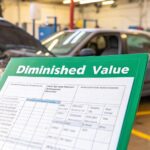Even after your car is perfectly repaired from an accident you didn’t cause, it’s worth less than it was before the crash. This loss in resale value is called ‘diminished value,’ and filing a claim is how you recover that money from the at-fault driver’s insurance company. You are legally entitled to this compensation, but you’ll need to provide proof to get what you’re owed.
Understanding Diminished Value and Your Claim
When another driver hits your car, their insurance is responsible for paying for the repairs. However, the story doesn’t end there. Your vehicle now has an accident on its permanent record, which significantly harms its fair market value.
Imagine you’re buying a used car and have two identical options. One has a clean history, while the other was in a collision. Which one would you choose? Most buyers would pick the one with no accident history or demand a steep discount for the one that was damaged.
That discount is the “diminished value.” It is a real financial loss you’ve suffered, regardless of how well the repairs were done. A diminished value claim is about recovering the drop in market value that occurred the moment the accident happened.
Third-Party vs. First-Party Claims: Who Do You File Against?
Understanding who to file your claim with is the first critical step. In nearly all cases, you will file a third-party claim. This means you are seeking compensation from the other driver’s insurance company because their policyholder caused the accident. This is the standard procedure across the United States.
A first-party claim, on the other hand, is when you file against your own insurance policy. This is rarely an option for diminished value, as most personal auto policies are written to cover the cost of repairs, not the loss of market value.
The rule is simple: the person who caused the damage is responsible for making you financially whole again. This includes compensating you for the value their client’s negligence erased from your property.
State Laws and The Legal Basis for Your Claim
Your right to file a diminished value claim is supported by solid legal precedent. While specific regulations differ by state, almost every state allows you to pursue a third-party diminished value claim. Some states have stricter rules or shorter deadlines (known as the statute of limitations), so it’s crucial to understand the laws where you live. For a complete guide, you can refer to SnapClaim’s breakdown of diminished value laws by state.
Key Takeaway: You are not asking for a favor. You are demanding fair compensation for a measurable financial loss caused by someone else. Knowing this gives you the confidence to negotiate effectively.
Successfully recovering your car’s lost value comes down to one thing: proof. Insurance companies are notorious for undervaluing these claims. A certified, data-driven appraisal provides the hard evidence needed to strengthen your claim and counter their lowball offers.
Do You Have a Valid Diminished Value Claim?
Before investing time and effort into filing a diminished value claim, you must first determine if you have a viable case. Not every accident qualifies, and insurance companies look for specific criteria to approve or deny a claim.
The good news is that the core eligibility requirements are straightforward.
Key Eligibility Factors for Your Claim
Your claim needs a solid foundation to be successful. If your situation meets these criteria, you are likely in a strong position to file for diminished value.
You were not at fault for the accident. This is the most important rule. Diminished value is paid by the at-fault driver’s liability insurance. If you caused the accident, your own policy will not cover this type of loss.
The damage was significant. While any accident technically diminishes value, claims for minor cosmetic issues like a paint scratch are rarely successful. The damage must be substantial enough to require professional repairs that will appear on a vehicle history report.
Your vehicle had a clean title before the crash. Insurance companies will argue that a vehicle with a prior accident history or a salvage title has already lost significant value. A clean record is essential for proving the loss came directly from this specific accident.
The at-fault driver has property damage liability coverage. This is standard in most auto insurance policies, but it’s a necessary component for the insurer to pay your claim.
How Your Vehicle’s Profile Affects the Claim Value
Beyond the basic requirements, your vehicle’s specific details play a major role in how much your claim could be worth. A newer car with low mileage and a higher fair market value will almost always have a stronger case for a larger payout. A two-year-old luxury SUV will lose far more value than a 10-year-old economy car with 150,000 miles.
Not sure if you qualify? The quickest way to find out is to use our free eligibility check.
Check Your Eligibility for Free in 60 Seconds
Step 1: Gather the Right Evidence to Build Your Case
Once you’ve confirmed your eligibility, it’s time to assemble the evidence needed to prove your loss. A strong diminished value claim is not based on your opinion; it’s built on a foundation of facts and official documentation. Your goal is to present a professional, organized case that leaves no room for the insurance adjuster to dispute your claim.
Essential Documentation Checklist
Each document you collect helps tell the story of your vehicle’s loss, making your argument for compensation undeniable.
Here is the core evidence you need:
Official Police Report: This document is the unbiased record of the accident and, most importantly, establishes who was at fault.
Photos and Videos: Take clear pictures of the damage from multiple angles before repairs begin. Afterward, take “after” photos to show the vehicle’s restored physical condition.
Itemized Repair Invoice: This is one of your most critical documents. It provides a detailed breakdown of every part, labor hour, and procedure, directly linking the accident to the changes that hurt your car’s resale value.
The Cornerstone of Your Claim: A Certified Appraisal Report
The single most powerful piece of evidence you can have is an independent, certified diminished value appraisal. While you can gather other documents yourself, an appraisal from a trusted provider like SnapClaim is what turns your request into a formal, fact-based demand.
Insurance companies often use their own flawed formulas, like the infamous “17c formula,” to generate insultingly low offers. A professional appraisal delivers an objective, data-driven valuation that their biased methods cannot easily dispute.
Key Insight: An independent appraisal shifts the power dynamic. You are no longer just another claimant asking for money. You become a prepared individual armed with a market analysis from a certified expert, forcing the adjuster to negotiate on your terms.
A SnapClaim report provides a comprehensive analysis that breaks down exactly how your diminished value was calculated. It references industry-standard valuation guides and market data to present a clear methodology that holds up under scrutiny. This level of proof supports your negotiations with the insurer and strengthens your claim significantly.
Step 2: Formally File Your Diminished Value Claim
With your evidence collected, it’s time to formally present your case to the at-fault driver’s insurance company. This step is about making a professional and undeniable demand for the compensation you are owed.
Your first action is to draft a formal demand letter. This letter serves as the official notice to the insurance adjuster that you are seeking compensation for your car’s diminished value. It should be a straightforward business communication that lays out the facts of your loss.
Crafting a Professional Demand Letter
Your demand letter must be direct, professional, and built around the evidence you’ve gathered. It is the cover letter for your entire claim package.
Here’s what to include:
Your Contact and Vehicle Information: Clearly state your name, address, phone number, the insurance claim number, and the year, make, and model of your vehicle.
A Clear Statement of Intent: Begin by stating that the letter is a formal demand for compensation for the diminished value of your vehicle resulting from the accident caused by their policyholder.
The Specific Demand Amount: State the exact dollar amount you are claiming. This number should come directly from your certified SnapClaim appraisal.
A List of Enclosed Documents: Itemize every piece of evidence you’re including, such as the police report, repair bills, and your full appraisal report.
Pro Tip: Keep your demand letter concise. Avoid emotional language or lengthy stories about the accident. Stick to the financial loss and the evidence that proves it.
Submitting Your Complete Claim Package
Once your letter is ready, send the entire package to the insurance adjuster. Your goal is to create an official record that your claim was submitted.
The best ways to send your package include:
Certified Mail with Return Receipt: This is the preferred method, as it provides a legal record that the insurance company received your documents on a specific date.
Email with a Read Receipt Request: This is faster, but be sure to request a read receipt to confirm the adjuster opened it.
Your submission should be a single, organized file containing your demand letter followed by copies of all supporting documents. By sending a complete and professional package, you demonstrate that you are serious and force the adjuster to address your evidence. Remember that diminished value laws by state can influence how an adjuster handles your claim, so being prepared is key.
Step 3: Negotiate a Fair Settlement
Once you file the claim, the negotiation process begins. Be prepared for the insurance adjuster’s first offer to be a lowball. Their job is to minimize payouts for their company. This is where your preparation and evidence become your greatest assets.
Responding to the Adjuster’s Arguments
Insurance adjusters often rely on the “17c formula,” an arbitrary internal calculation used to cap diminished value payouts. It has little to do with your car’s actual loss in market value. When the adjuster presents a low offer based on this formula, don’t argue about the formula itself. Instead, calmly pivot the conversation back to your evidence.
You can say something like:
“Thank you for that offer. My claim isn’t based on an internal formula, but on a real-world market analysis of my vehicle, which is detailed in the certified appraisal I provided. Can you please show me the market data you used to arrive at your figure?”
This simple question puts the burden of proof back on them to justify their offer with market data, which they rarely have. It forces them to stop hiding behind their formula and start addressing the facts in your SnapClaim report.
Common Adjuster Tactics and How to Respond
The Quick Low Offer: They may offer a fast, low amount, hoping you’ll take the easy money. Politely decline and reiterate that your claim is based on the certified appraisal you provided.
Claiming No DV is Owed: They might argue that high-quality repairs mean there is no diminished value. Gently remind them that DV is about the permanent loss in market value from the accident history, not the quality of the repair.
The Silent Treatment: If they stop responding, don’t give up. Send a polite but firm follow-up email every few days to keep your claim active.
The key is to remain professional and persistent. This is a business transaction, and you are simply presenting the facts of your financial loss. Your certified SnapClaim appraisal is your most powerful tool, providing a data-driven analysis of your car’s true loss in value. It gives you the credibility needed to stand your ground and negotiate effectively.
Furthermore, we back our service with a money-back guarantee: if the insurance recovery from your claim is less than $1,000, your appraisal fee is fully refunded. This allows you to negotiate with confidence and zero financial risk.
What to Do If the Insurance Company Denies Your Claim
Sometimes, despite solid evidence, an insurance adjuster may deny your claim or refuse to offer a fair settlement. This is not the end of the road; it’s simply time to escalate the matter.
If you aren’t making progress with the adjuster, your first step is to politely ask to speak with their manager or a claims supervisor. A supervisor often has more authority to approve a higher payout and may be more willing to negotiate to avoid further complications.
Taking Formal Action
If escalating internally doesn’t work, your next step is to file a formal complaint with your state’s Department of Insurance. This government agency regulates insurers and can investigate claims of bad faith. While they can’t force a specific payment, an official complaint often prompts the insurer to seek a fair resolution.
For larger claims, small claims court is another powerful option. It’s designed to be accessible without a lawyer. Presenting your organized evidence—the police report, repair invoices, and your SnapClaim report—to a judge can be very effective. Many insurers would rather settle than go to court. For more details on this process, you can find information at trusted consumer resources like TeamJustice.com.
Persistence Pays Off: Many vehicle owners who are initially denied or lowballed find success by calmly escalating the issue and showing they are prepared to take further action.
Your certified appraisal from SnapClaim is more than a negotiation tool; it is court-ready evidence that substantiates your loss and provides the leverage you need to fight for the compensation you deserve.
Frequently Asked Questions About How to File a Diminished Value Claim
Can I file a diminished value claim if I was at fault?
No. Diminished value claims are filed against the liability insurance of the at-fault driver. Your own policy covers the cost of repairs to your vehicle, not the reduction in its market value. The person responsible for the damage must compensate you for your financial loss.
How long do I have to file a diminished value claim?
Every state has a time limit, known as the statute of limitations, for filing property damage claims. These deadlines generally vary from two to six years from the date of the accident. It is essential to review the specific laws in your state by visiting our diminished value state laws guide and to begin the process promptly once your repairs are completed.
Is a professional appraisal report necessary to file a claim?
While not legally required, a professional appraisal is the most crucial piece of evidence for a successful claim. Insurance adjusters often use internal formulas like the “17c formula,” which you can explore further on sites like Experian.com, to undervalue claims. An independent report from SnapClaim provides objective, market-based proof of your actual loss, enabling you to negotiate a fair settlement.
Can I file a diminished value claim if my vehicle is leased?
Yes, you can file a diminished value claim on a leased vehicle. The process is similar to filing for an owned vehicle, as it involves proving the loss in market value due to the damage. It is vital to check your lease agreement and discuss with your leasing company any requirements or restrictions.
What if the insurance company denies my diminished value claim?
If your claim is denied, you can appeal the decision. It’s important to gather all supporting documentation, including the appraisal report, and clearly outline why the denial is unfounded. You may also consider seeking legal advice or assistance from a claims adjuster to strengthen your case.
For a comprehensive appraisal report, visit SnapClaim to order your diminished value appraisal and ensure you have the necessary documentation to support your claim.
Ready to get the proof you need to get paid fairly? SnapClaim delivers court-ready, certified appraisal reports backed by real-time market data. Start with a free estimate to see what your claim is really worth.





